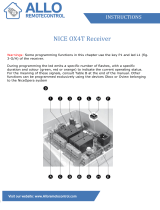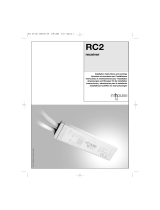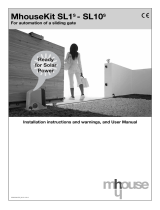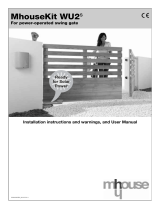Page is loading ...

control units
Instrukcje i uwagi dla instalatora
Istruzioni ed avvertenze per l’installatore
Instructions and warnings for the fitter
Instructions et recommandations pour l’installateur
Anweisungen und Hinweise für den Installateur
Instrucciones y advertencias para el instalador
mindy TT1N
Aanwijzingen en aanbevelingen voor de installateur

2
2.1.1) Motor connection
The single-phase asynchronous motor powered by the electrical
mains must be connected on terminals 1-2-3-4 (DOWN, COMMON,
UP, EARTH).
“DOWN” is controlled by the ▼ key on the remote control, and “UP”
by the ▲ key. (anemometer intervention direction).
If the rotation direction is not correct, invert the terminals 1 and 3.
do not connect more than one motor to each control unit;
if necessary, use the appropriate expansion cards.
!
2.1.2) Power supply
The main supply to the unit must be connected using the terminals 5-6-7 (earth, phase, neutral) as shown in Fig. 4
The TT1 control unit enables the control of a single-phase asynchro-
nous motor powered by the electrical mains, with “COMMON” “UP”
“DOWN” type connections, and used for the automation of awnings,
rolling shutters and similar fixtures.
The control unit incorporates a radio receiver operating at a frequen-
cy of 433.92 MHz, with rolling code technology that guarantees high
levels of security. Up to 30 transmitters (“ERGO” fig. 1, “PLANO” fig.
2) or radio-controlled sensors (“VOLO S RADIO” fig. 3) can be
memorized for each control unit. After each command, the motor is
powered for the operating time required. An electric limit switch
incorporated in the motor stops the movement when the desired
position is reached. The programming can be done directly from the
transmitters, with beeps that sound to guide users through the vari-
ous phases. “VOLO S RADIO” climatic sensors (Fig. 3) enable users
to manage the movement of the awnings or rolling shutters auto-
matically, depending on the wind, sun or rain conditions.
N.B.: Besides “ERGO”, “PLANO” and “VOLO S RADIO”, the control
unit can manage other kinds of transmitters and functioning modes,
too. Please refer to Chapter 4 “Additional information” for further
explanations.
Warnings
The TT1 control unit is suitable for the control of a single-phase asyn-
chronous motor powered by the electrical mains and used for the
automation of awnings, rolling shutters and similar fixtures.
Any other use is improper and prohibited. The unit must be installed by
qualified technicians in compliance with the electrical and safety regula-
tions in force.
1) Product description
N
L
5
4
COM
M
6 7
3 2 1
2.1) Electrical connections
Carefully follow all the connection instructions, if you have
any doubts do NOT make experiments but consult the rele-
vant technical specifications sheets which are also available
on the web site www.niceforyou.com
An incorrect connection may cause serious damage to the
control unit.
!
2) Installation
The electrical systems and automations must be installed by
qualified and experienced personnel in compliance with current
legislation. Before you proceed to make any connections make
sure that the power supply is disconnected.
1. Strip the motor cable and the power supply cable about 3 cm
and then the single wires approx. 5 mm.
2. Open the container by removing the “cable cap” as shown in fig. 5.
3. Thread the two cables through the designated holes in the “cable
cap” (see fig. 6).
4. Pull the card a few centimetres out of the container (see fig. 7).
5. Connect the wires to the terminals as shown in fig. 8, observing
the diagram in fig. 4 and the operations described in chapter 2.1.
6. Fold the cables as shown in fig. 9.
7. Push the card inside the container, make sure that the stripped
length of the cable is fully inside the container, then slide the “cap”
until the container closes completely (see fig. 10)
8. The control unit can be fitted directly in the shutter/awning box,
double-sided tape can be used for this. To avoid the risk of water
leaks it should be positioned with the cables towards the bottom
as shown in Fig. 11. Do not place it with the cables towards the
top (Fig. 12).
Do not perforate the container.
!
!
4
1
ERGO
2
PLANO
3
VOLO S RADIO

GB
3
2.1.3) Weather sensors
The control unit manages the climatic sensors by means of a “VOLO
S RADIO”-type radio (max. no. 3). Memorisation of a “VOLO S
RADIO” sensor must be carried out like that of a normal transmitter.
Follow the procedure set out in Table “A2”. Intervention levels must
be programmed actually on the “VOLO S RADIO” sensor.
Wind intervention levels must be given priority, followed by the rain and
sun. Please refer to the “VOLO S RADIO” manual for further details.
interventions on the anemometer provoke a command
equivalent to the ▲ key command on the transmitters
!
Each transmitter or radio sensor is recognised by the control unit by
means of an unequivocal “code”. A “memorisation” phase must
therefore be performed in order to allow the control unit to recognise
each single transmitter.
• All the memorisation sequences are timed, that is, they
must be completed within the programmed time limits.
• For transmitters with multiple “groups”, choose the group
the motor must be associated with before proceeding with
the memorisation phase.
•Programming via radio may be done on all the control units
within the range of the transmitter; therefore, only the one
involved in the operation should be kept switched on.
!
3) Programming
1. As soon as the control unit is powered, 2 long beeps will sound
2. Within 5 seconds press and hold down button ■ of the transmitter to be memorised
(for approx. 3 seconds) 3s
3. Release button ■ when you hear the first of the 3 beeps confirming memorisation
N.B. If transmitters have already been memorised in the control unit, 2 short beeps will be heard when it is switched on. This means that
the above procedure is not valid and another memorisation procedure must be used (Table “A2”).
When the memory contains no codes the first radio control unit can be entered as follows:
1. Press and hold down button ■ of the new transmitter until you hear a beep
(after about 5 seconds) then release it New 5s
2. Press button ■ of a previously memorized transmitter slowly 3 times
Old X3
3. Press button ■ on the new transmitter again, releasing it when you hear the first of the 3 beeps.
New
N.B. 3 long beeps will sound if memorisation has been successfully completed. 6 beeps will sound when the memory is full (30
transmitters), telling you the transmitter cannot be memorised.
When one or more transmitters have already been memorised, others may be enabled as follows:
Table “A1” Memorizing the first transmitter (fig. 13) Example
Table “A2” Memorizing the first transmitter (fig. 14) Example
A Switch the control unit off and cut the jumper on the weld side of the card (see fig. 15).
B Power the control unit and wait for the initial beeps
1 Press and hold down button ■ of a previously memorized transmitter until you hear a beep
(after about 5 seconds) then release it. 5s
2 Press and hold down button ▲ of the transmitter until you hear 3 beeps;
release button ▲ exactly during the third beep.
3 TPress and hold down button ■ of the transmitter until you hear 3 beeps;
release button ■ exactly during the third beep.
4 Press and hold down button ▼ of the transmitter until you hear 3 beeps;
release button ▼ exactly during the third beep.
5 If you wish to delete all the data in the memory, press the ▼ ▲ keys simultaneously
within 2 seconds until you hear the first of 5 beeps, then release them.
N.B. 5 beeps will sound, indicating that all the codes in the memory have been deleted.
If you need to delete all the data contained in the memory of the
control unit, carry out the following procedure.
The memory can be deleted:
• using a non-memorised transmitter starting from point A.
• using a previously memorised transmitter starting the procedure
from point N. 1
You can delete:
• the transmitters only, by stopping at point 4 of the procedure;
• all the data (transmitters and programming the working time), by
carrying out the procedure through to point 5.
➨
➨
Table “A3” Memory deletion (fig. 15) Example
➨

4
3.1) Programming the “Working time”
The “Working Time” is the time during which the control unit commands
the motor, and both the factory time and the time after the memory has
been deleted are approximately 150 seconds. If necessary, the running
time can be altered from a minimum of 4 seconds to a maximum of 240.
The programming procedure is carried out in the “self-recognition” state, or
better, by measuring the time necessary to carry out the entire manoeuvre.
The motor must be moved and set next to a limit switch and the
most difficult (and therefore slowest) manoeuvre for the motor mea-
sured. This is normally re-winding. The manufacturer recommends
that users programme a working time which is a few seconds longer
than the time which is strictly necessary for the manoeuvre.
1. Press and hold down button ■ of a previously memorized transmitter until you hear a beep
(after about 5 seconds) then release it. 5s
2. Press key ■ again until you hear 4 short beeps (after approx. 5 seconds), then release
5s
3. Press keys ▲ (or ▼)¸ in order to begin the manoeuvre and start up the time counting phase.
4. Wait for the motor to finish the manoeuvre and after a few seconds press key ■ to stop
the time count. Three beeps will indicate the new working time has been memorised successfully.
N.B. If the user wishes to reset the factory time of 150 seconds, at point 3 s/he must press key 5 until s/he hears the first of 3 beeps
indicating programming has taken place.
Table “A4” Programming the working time (fig. 16) Example
4.1) Usable transmitters
The transmitters which can be used are shown in Table “A5”, together with
their relative radio coding.
The transmitters have different kinds of coding, and the control unit is unable to recognise them simultaneously. The first transmitter memo-
rised will thus determine the type of coding, and consequently the transmitters which can be memorised successively .
All codes must be deleted if the user wishes to change the type of transmitter (see tables “A3” “A10”).
The type of code can be checked by counting the number of beeps which sound when the control unit is switched on.
CODIFICA Trasmettitori
ERGO1 - ERGO4 - ERGO6
PLANO1 - PLANO4 - PLANO6 - PLANO TIME
FLOR Rolling code VOLO S RADIO
FLO1R - FLO2R - FLO4R
VERY VR
SMILO Rolling code SM2 - SM4
FLO Fixed code
FLO1 - FLO2 - FLO4
VERY VE
Table “A5”
4) Additional Information
Besides the transmitters from the “ERGO” and “PLANO” series, the
control unit will also recognise other kinds of transmitters manufac-
tured by NICE (please refer to Chapter 4.1 “Usable transmitters”).
By using a special memorisation procedure for the transmitters, it is
also possible to associate a special command to each of the trans-
mitter keys (refer to Chapter 4.2 “Programming transmitters in Mode
I and Mode II”).
BIP Types of coding for the transmitters memorised
1 short beep Transmitters with FLO coding
2 short beeps Transmitters with FLOR coding
3 short beeps Transmitters with SMILO coding
2 long beeps Empty memory (no memorized transmitter)
Table “A6”
4.2) Memorizing the transmitters in Mode I and Mode II
Tables “A1” and “A2” show the memorisation of transmitters in Mode
I, where each key is allocated a command:
key 1= ▲ = ASCENT
key 2 = ■ = STOP
key 3 = ▼ = DESCENT
The transmitters can also be memorised in Mode II. This mode gives
the user the most flexibility when using the transmitters.
Transmitters in both Mode I and Mode II can be memorised in the
same control unit.
The differences between the 2 programming modes have been
described below:
FLO4R
VERY SM2 SM4
ERGO
PLANO VOLO S RADIO

GB
5
4.2.1) Mode I
In this mode, the command associated with the transmitter keys is fixed: key 1 (or ▲)
commands the ascent, key 2 (or ■) commands a stop, key 3 (or ▼) commands the
descent, key 4 (if present) commands a stop.
A single memorization stage is carried out for each transmitter; during this stage it
does not matter which key is pressed, and only one space is occupied in the
memory.
Please refer to Chapter 3 “Programming” for information about how to memorise or delete the transmitters.
Esempio memorization Mode
Key 1 or ▲ ASCENT
Key 2 or ■ STOP
Key 3 or ▼ DESCENT
Key 4 STOP
Example 1 memorization Mode II
Key 1 ASCENT on TT1N no. 1
Key 2 DESCENT on TT1N no. 1
Key 3 ASCENT on TT1N no. 2
Key 4 DESCENT on TT1N no. 2
4.2.2) Mode II
This mode enables the user to associate one of the following commands 1 “step step” (ascent-stop-descent-stop…), 2 “ascent”, 3
“descent”, 4 “stop” with the keys on the transmitter.
Memorisation must be carried out again if the user wishes to allocate another command to another key on the same transmitter.
The choice of which key to press is important during this phase, and space in the memory will be used up for each key memorised.
• The running time cannot be programmed if a transmitter is memorised in Mode II.
•A transmitter programmed in Mode II cannot be used in the “multi-group” mode.
When the memory contains no transmitters the first one can be memorized in mode II as follows:
one or more transmitters have already been memorized, others may be enabled in Mode II as follows:
Example 2 memorization Mode II
Key 1 STEP-BY-STEP on TT1N no. 1
Key 2 STEP-BY-STEP on TT1N no. 2
Key 3 ASCENT on TT1N no. 3
Key 4 DESCENT on TT1N no. 3
1. 2 long beeps will sound as soon as the control unit is powered.
2. Press the transmitter key to be memorised within 5 seconds, and hold it down until
you hear all 3 beeps indicating memorisation has taken place, then release. 5s
3. Within 3 seconds press the same key of the transmitter as many times as the number
corresponding to the desired command: 1 = “step-by-step” 2 = “ascent” 3 = “descent” 4 = “stop”
1-4 3s
4. After approximately 3 seconds, the user will hear a certain number of beeps.
These beeps correspond to the command selected. 1-4 3s
5. Press the same key again within 2 seconds to confirm programming.
Release this key when you hear the first of the 3 beeps. 2s
N.B. 3 long beeps will sound if memorization has been successful. If, at point 4, the user does not hear the same number of beeps as the
command required, wait for a few seconds to exit the procedure, without confirming the memorisation.
Table “A7” Memorizing the first transmitter in mode II Example
1. Press and hold down the new button to be memorized until you hear a beep
(after about 5 seconds) then release it
New 5s
2. Within 5 seconds, press and hold down the key of a transmitter which has already been
memorised (old) for approximately 5 seconds, until you hear 2 quick beeps, then release.
Old 5s
3.
Within 5 seconds press the same key of the (old) transmitter as many times as the number
corresponding to the desired command: 1 = “step-by-step” 2 = “ascent” 3 = “descent” 4 = “stop” Old
1-4
5s
4. After approximately 3 seconds you will hear several beeps. The number of these beeps will
be the same as the previously selected command. 1-4 3s
5.
Press the new key of the transmitter to memorise again within 2 seconds to confirm programming.
Release when you hear the first of the 3 beeps New
2s
N.B. 3 long beeps will sound if the memorization procedure has been successful. When the memory is full (30 transmitters), 6 beeps will
sound to indicate that the transmitter cannot be memorised.
Table “A8” Memorizing other transmitters in Mode II Example
!

6
A new transmitter can easily be memorised, keeping the same features as the old transmitter, by following the procedure detailed in Table
“A9”.
Any new transmitters which are memorised in this manner will take on the same characteristics as the old one. If the old one was memo-
rised in Mode I, the new one will also operate in Mode I. If, on the other hand, the old one was memorised in Mode II, the key of the new
transmitter will also be associated to the same command as the old one..
1. Hold down the key of the new transmitter you wish to memorise for at least 3 seconds,
then release.
New 3s
2. Press the key of the (old) transmitter which has already been enabled for at least 3 seconds,
then release.
Old 3s
3. Press the key of the new transmitter again for at least another 3 seconds, then release.
New 3s
4. Press the key of the old transmitter again until 3 beeps sound to confirm the new
transmitter has been memorised.
Old 3s
N.B. 6 beeps will sound when the memory is full (30 transmitters) in order to indicate that the transmitter cannot be memorised.
Table “A9” Memorizing other transmitters (fig. 14) Example
If you need to delete all the data contained in the memory of the control unit by using a transmitter memorized in Mode II, carry out the
following procedure.
You can delete:
• the transmitters only, by stopping the procedure at point 4;
• all the data (transmitters and programming of the running time), by following the procedure through to point 5.
1. Press and release a key memorised in Mode II. Do not worry if the motor starts up.
Press the same key of the transmitter again and keep it pressed down (the motor must be off)
until you hear a beep, after approximately 5 seconds, then release. 5s
2. Press the same key of the transmitter again and keep it pressed down until you hear 3 beeps.
Release the key during the third beep.
3. Press the same key of the transmitter again and keep it pressed down until you hear 3 beeps.
Release the key during the third beep.
4. Press the same key of the transmitter again and keep it pressed down until you hear 3 beeps.
Release the key during the third beep.
5. If you wish to delete all the data in the memory completely, press the same key again within 2
seconds, then release it. 2s
N.B. After a few seconds, 5 beeps will sound to indicate that all the codes in the memory have been deleted.
Table “A10” Memory deletion with transmitter memorized in Mode II Example
When the control unit is switched on, no beep sounds and the
transmitters do not transmit any commands.
Make sure that the control unit is powered correctly: there must be
mains voltage between terminals 6-7. If the power supply is correct,
there is likely to be a serious fault in the system, and the control unit
will have to be replaced.
After a radio command, you hear 6 beeps and the manoeuvre
does not start
The radio control is out of synch, the transmitter memorization pro-
cedure must be repeated.
After a radio command, you hear 10 beeps and then the
manoeuvre starts
The self-diagnosis of the parameters in the memory has detected a
fault. In this case, the user must delete the entire memory, memorise
the remote controls and programme the running time.
You are unable to programme the running time following the
procedure detailed in Table “A4”
If you are unable to programme the running time with the transmit-
ters memorised in Mode II, check that the remote control has been
inserted in the memory in Mode I (key ▲ = ASCENT, key ■ 5 =
STOP, key ▼ = DESCENT)
The motor is “off”, but at times you have to give the step step
command twice in order to start it up.
It may be that the programmed running time is far too long for the
effective duration of the manoeuvre. As the motor will have stopped
next to a limit switch, the control unit may “think” the motor is still
moving because of a previous command. In this case, the first com-
mand is interpreted as a STOP and the second as a movement
command. Therefore, the user simply has to programme the running
time correctly in order to solve the problem (refer to Chapter 3.1 )
5) What to do if… a short troubleshooting guide!
➨

GB
7
6) Technical characteristics
All technical specifications refer to a temperature of 20°C.
Electronic control unit
Power supply : 230Vac (+10-15%) 50Hz
Maximum motor power : 500W / 400VA
Operating temperature : -20 ÷ 50 °C
Dimensions / weight : 98 x 26 x 20 / 45g
Protection class : IP55 (container undamaged)
Time taken by manoeuvre : From 4 to 250 seconds (factory setting approx. 150 sec.)
Radio receiver
Frequency : 433.92MHz
Coding : FLO (fixed code), FLOR (rolling code) SMILO (rolling code)
N°. of transmitter that can be memorised : 30 (max. 3 weather sensors)
Range of the transmitters :estimated 150 m outdoor, 20 m indoor. *
* The capacity of the transmitters is strongly influenced by other devices with continuous transmissions which operate at the same frequency.
These include alarms, headphones, etc… which interfere with the control unit receiver.
Nice S.p.a reserves the right to make changes to its products at any time as it deems necessary
Declaration of conformity N°: mindy TT1N Rev 0
Nice S.p.a. via Pezza Alta, 13 Rustignè Oderzo (TV) ITALY
declares that the product: “TT1N” complies with the essential safety provisions of Directives:
R&TTE 1999/5/CE
date General Manage
20-01-2004 Lauro Buoro

IST 158 4858 REV. 00
Nice SpA
Oderzo TV Italia
Tel. +39.0422.85.38.38
Fax +39.0422.85.35.85
Nice Padova
Sarmeola di Rubano PD Italia
Tel. +39.049.89.78.93.2
Fax +39.049.89.73.85.2
Nice Roma
Roma Italia
Tel. +39.06.72.67.17.61
Fax +39.06.72.67.55.20
Nice France
Buchelay
Tel. +33.(0)1.30.33.95.95
Fax +33.(0)1.30.33.95.96
Nice Rhône-Alpes
Decines Charpieu France
Tel. +33.(0)4.78.26.56.53
Fax +33.(0)4.78.26.57.53
Nice France Sud
Aubagne France
Tel. +33.(0)4.42.62.42.52
Fax +33.(0)4.42.62.42.50
Nice Belgium
Leuven (Heverlee)
Tel. +32.(0)16.38.69.00
Fax +32.(0)16.38.69.01
Nice España Madrid
Tel. +34.9.16.16.33.00
Fax +34.9.16.16.30.10
Nice España Barcelona
Tel. +34.9.35.88.34.32
Fax +34.9.35.88.42.49
Nice Polska
Pruszków
Tel. +48.22.728.33.22
Fax +48.22.728.25.10
Nice China
Shanghai
Tel. +86.21.525.706.34
Fax +86.21.621.929.88
www.niceforyou.com
Nice Gate is the doors and gate automation division of Nice Nice Screen is the rolling shutters and awnings automation division of Nice
13
ON
14
~3 s
+5 s X3 X1
5
9 10 11
6 7 8
12
15
2 s
Only TX
3° bip
3° bip 3° bip+5 s
-2 s X 1
All
16
+5 s +5 s
/










